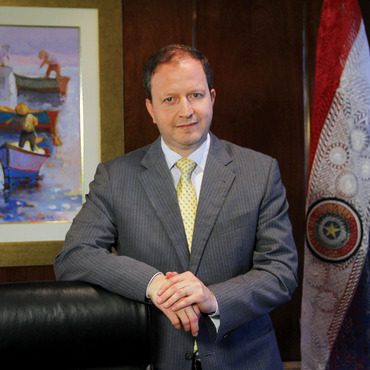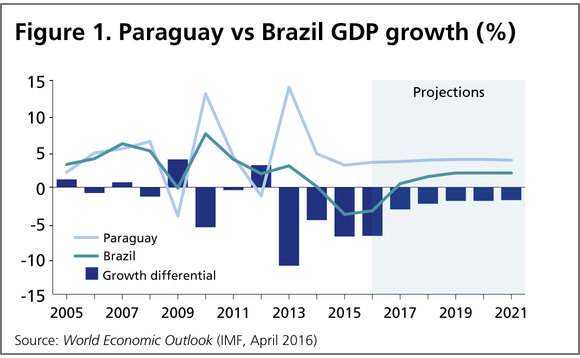
Central bank governor of the year: Carlos Fernández Valdovinos
A success story at the heart of Latin America

Carlos Fernández Valdovinos set himself three primary goals when he took over as governor of the Central Bank of Paraguay in 2013: to consolidate the central bank's inflation-targeting regime; to enforce major legal reforms in the banking sector; and to put the country's solid macroeconomic fundamentals in the international spotlight.
Achieving these goals would be no easy task – not least because the former senior economist at the International Monetary Fund (IMF) took on his position just as China's rebalancing of its economy led to a slump in commodity prices. This hurt Latin America's commodity exporting nations. The region's two largest economies – and Paraguay's biggest trade partners – Brazil and Argentina were also hit by a wave of political upheaval.
Valdovinos would need skills well beyond those he had garnered from his time in academia, having worked as a professor at the Universidad Nacional de Asunción and Universidad Católica Nuestra Señora de la Asunción as well as lecturing in the US at Georgetown University and the University of Chicago, where he earned his doctorate. Reaching his goals would require strong leadership, relentless determination and powerful communication combined with a deep-rooted conviction that with the right internal conditions a small economy could achieve prominence at a time when growth across the globe was faltering.
Structural reforms and the co-ordination of monetary and fiscal policy have helped Paraguay achieve remarkable levels of economic output. In 2016, as the economy of Latin America as a whole contracted by 0.6%, Paraguay expanded by 4%.
Undoubtedly, favourable weather conditions over the past 18 months have helped boost the agriculture sector as well as electricity production. The US Department of Agriculture predicts the nation will harvest 9.13 million tonnes of soybeans, Paraguay's largest export, in the 2016/2017 season. Paraguay's low levels of taxation and its geographical location have also acted as incentives to attract investment from neighbouring nations.
Controlling inflation
Stable prices have also played a key role. Valdovinos and his team have successfully managed to keep the inflation outlook below the bank's 4.5% target throughout his tenure, despite using accommodative monetary policy in an attempt to shore up the economy when international shocks sent growth into negative territory.
The Central Bank of Paraguay adopted a full inflation-targeting regime, abandoning its exchange rate regime, almost immediately after Valdovinos took office. After fine-tuning and consolidating the tool initially implemented by his predecessor, Jorge Corvalán Mendoza, Valdovinos – under unfavourable conditions – altered the central bank's commitment to price stability by reducing not only the inflation tolerance bands (from ± 2.5 percentage points to ± 2 percentage points), but also the target rate (from 5% to 4.5% for 2015 onwards).
"Carlos Fernández Valdovinos has earnestly striven to enhance the independence of the Central Bank of Paraguay and succeeded in holding price stability through inflation targeting," Central Bank of Argentina governor Federico Sturzenegger tells CentralBanking.com. "Thus, he has contributed towards a sustained economic growth of his country and made substantial progress in the direction of financial inclusion."
 While the inflation-targeting regime has proven effective at keeping prices under control, Valdovinos has not shied away from supporting the broader economy when the opportunity has arisen. In 2015, when oil prices bottomed out at less than $30 per barrel, the economies of Paraguay's largest trading partners – Argentina and Brazil – crashed. The central bank's first move was to allow the local currency – the guaraní – to depreciate by 25%. The exchange rate move had no significant pass-through effect on the inflation rate, and the governor stated clearly that the $7 billion of foreign exchange reserves (26% of GDP) held at the central bank would be deployed to shield the economy from external shocks, should the need arise.
While the inflation-targeting regime has proven effective at keeping prices under control, Valdovinos has not shied away from supporting the broader economy when the opportunity has arisen. In 2015, when oil prices bottomed out at less than $30 per barrel, the economies of Paraguay's largest trading partners – Argentina and Brazil – crashed. The central bank's first move was to allow the local currency – the guaraní – to depreciate by 25%. The exchange rate move had no significant pass-through effect on the inflation rate, and the governor stated clearly that the $7 billion of foreign exchange reserves (26% of GDP) held at the central bank would be deployed to shield the economy from external shocks, should the need arise.
Once Valdovinos had ensured inflation expectations were anchored, he took advantage of the policy space to adopt a more accommodative monetary policy stance to support economic activity, lowering interest rates by 100 basis points in 2015. His effective communication and policy strategy paid off, contributing to Paraguay's recent economic performance.
"Carlos has conducted a prudent but effective monetary strategy, and has been a voice of authority and transparency in shaping the goals and instruments of economic policy in his country," says former Central Bank of Argentina governor Mario Blejer.
During Valdovinos's tenure, inflation has remained below the bank's 4.5% target, making Paraguay the only South American nation to achieve inflation within its designated band range for the last three years.
"The economic performance of Paraguay has been nothing short of extraordinary," says Blejer. "The country has achieved and maintained price stability despite a substantial exchange rate adjustment."
Latin America's ‘mini-China'
Many of the Latin American nations that grew rapidly during the commodity boom years had their economies boosted by strong raw material imports to China. But as the Chinese economy undergoes a transition away from heavy industry, demand for commodity imports has slowed, resulting in regional growth crawling to a halt. Some countries, which did not control their deficits during the boom years, have been forced to increase taxes and cut government spending to meet their debt obligations. This has put pressure on their central banks to ease monetary policy despite inflationary pressures.
But the Paraguayan government managed to boost productivity by increasing infrastructure spending. In 2016, 39% of total public spending was allocated to infrastructure projects, with a national programme to upgrade the country's network of roads, railways and airports currently under way.
Valdovinos is concerned the global economy is coming to the end of a commodity 'super-cycle', which could represent the 'golden years' of Latin America, according to comments he makes in an interview with CentralBanking.com. Since taking on the role of governor, Valdovinos has been a strong advocate for implementing structural reforms to support the economy, rather than over-relying either on government spending and/or looser monetary policy to encourage growth. Much of that push comes in trying to diversify exports away from commodities.
"Paraguay is undergoing a period of production diversification. We will continue to be a soybean and beef exporter, but we are also becoming more deeply involved in the production chains linked with Brazilian industry," says Valdovinos.
The governor has big aspirations for Paraguay in this regard, most notably taking on China. Currently, Brazil imports around $70 billion a year from Chinese factories. Valdovinos believes Paraguay can offer a cheaper alternative, giving the small nation a competitive advantage over the Asian giant. For Paraguay, Brazil accounts for 26% of imports and 33% of exports on average over the past five years.
"Brazilian companies have looked at the costs in Brazil and found Paraguay has energy prices around 40% lower, plus a 10:10:10 tax system: 10% value-added tax, 10% corporate tax and 10% personal income tax," explains Valdovinos. "Brazilian companies therefore have somewhere where production costs are cheaper. We can no longer rely on high commodity prices, so attracting investment from our neighbours has become very important."
 Between September 2015 and August 2016, over 40 Brazilian companies – encouraged by the Brazilian National Confederation of Industry – decided to transfer part or all of their production lines to Paraguay. For example, in 2015, industrial gas manufacturer Oxygroup closed its operations in Pará, Minas Gerais state, and moved to Paraguay, investing more than $7.5 million in the transfer.
Between September 2015 and August 2016, over 40 Brazilian companies – encouraged by the Brazilian National Confederation of Industry – decided to transfer part or all of their production lines to Paraguay. For example, in 2015, industrial gas manufacturer Oxygroup closed its operations in Pará, Minas Gerais state, and moved to Paraguay, investing more than $7.5 million in the transfer.
In 2016, the central bank took a step closer towards better integration with its big Latin American neighbour through the establishment of a payment system that will allow Paraguay and Brazil to trade via a local currency payment system. Importers and exporters will be able to make and receive payments in their own currencies, avoiding a situation where both parties are forced to exchange to/from US dollars before completing a transaction. Payments processed by the system include transactions of goods and services, pensions, remittances and other small-value transfers.
Embracing other tools
Macro-prudential policies are also high on the Paraguayan governor's list of how to combat challenges stemming from what he and others have dubbed ‘the new normal' – an environment marked by low growth and record-low interest rates.
"We have learnt a lot regarding macro-prudential, micro-prudential and monetary policy during the recent global crisis. I mean, inflation seemed fine, individual banks appeared stable, and then suddenly the whole system collapsed. So something was missing," Valdovinos says in the interview. However, the world of macro-prudential tools is still relatively new to policymakers.
"We are learning," he says, when asked about Paraguay's experience with macro-prudential tools. "Most of the tools were applied in emerging markets, and not in advanced economies. Some of them have been quite useful in preventing potential problems in the banking sector. But there is always the 'what if' scenario: 'What would have happened, had I not implemented this policy?' You never know."
The central bank is currently reviewing whether to impose different capital requirements on dollar-denominated loans in an attempt to gradually promote de-dollarisation.
Legal footprint
Valdovinos has also made his mark on the legal underpinning of the central bank with the aim of improving financial stability. After 20 years, the legal framework for financial supervision and regulation – both mandates of the central bank – were updated in 2016, granting additional new powers to the Central Bank of Paraguay alongside a revised regulatory framework. The new legislation introduces prudential measures that will be essential to allow the central bank to implement a risk-based financial supervision scheme.
Indeed, it appears to be a Valdovinos hallmark to take advantage of favourable domestic macroeconomic conditions and a vigorous but stable financial system to adjust banking laws more in line with international best practice. Throughout the process, the governor negotiated with both the private sector and members of the senate to help markets and politicians understand the importance of reforms. Now in place, the new laws give lenders greater flexibility in dealing with changed market conditions. The changes also strengthen central bank governance.
"The current law has been useful for the last 10–15 years, but right now we need more flexibility regarding how to define capital, what is going to be the risk weight for an asset within a specific bank, and we also need to regulate systemic banks differently to small banks," Valdovinos says.
Carlos has conducted a prudent but effective monetary strategy, and has been a voice of authority and transparency in shaping the goals and instruments of economic policy in his country
Former Central Bank of Argentina governor Mario Blejer
Given his grasp of the issues, it is perhaps surprising that Valdovinos is not a career central banker – although he served as the section head for monetary programming in 1991–92 and served as an adviser to the chief economist from 1999 until 2001, and then as chief economist from 2001 until 2004. But, in some ways, his international experiences have provided him with greater perspective.
Valdovinos has served as a senior economist for Argentina at the World Bank – a post he held for two years before joining the IMF as senior economist for country missions to Africa, Europe and the western hemisphere. From 2011 until his appointment as governor – his current term will continue until 2018 – he served as IMF resident representative for Brazil and Bolivia. As a result, since becoming governor, Valdovinos has become a key member of Paraguay's economic team by providing strategic advice with regard to sovereign bond issuances and taking part in important economic policy decisions at the national level. "He is most certainly an architect of Paraguay's success," says Blejer.
Amid challenging global economic conditions, Paraguay has successfully issued sovereign bonds in the international market four times since 2013. For example, in March 2016, Paraguay announced the offering of $500 million of 10-year senior unsecured notes. Because of the issue being five times oversubscribed, the size of the bond offering was increased to $600 million. The governor played an active role during the roadshow and pricing negotiations, engaging with investors by promoting the country's macroeconomic fundamentals.
And his success is not just reflected in the performance of the economy. Since becoming governor, Valdovinos has helped to boost the image of Paraguay internationally. For the first time in 19 years, a Paraguayan was elected to the board of governors of the Center for Latin American Monetary Studies for a period of two years.
Alexandre Tombini, an executive director at the IMF and former governor of the Central Bank of Brazil, tells CentralBanking.com: "Carlos has established strong links with our country in his academic and professional life. Since becoming governor, he has played a key role in fostering the dialogue among South American central bankers on critical issues during challenging times."
He has also been the first Paraguayan governor invited to participate in panel discussions at conferences hosted by the US Federal Reserve, IMF and World Economic Forum. It seems international peers want to learn more from the Paraguayan governor.
Image: www.bcp.gov.py
Only users who have a paid subscription or are part of a corporate subscription are able to print or copy content.
To access these options, along with all other subscription benefits, please contact info@centralbanking.com or view our subscription options here: subscriptions.centralbanking.com/subscribe
You are currently unable to print this content. Please contact info@centralbanking.com to find out more.
You are currently unable to copy this content. Please contact info@centralbanking.com to find out more.
Copyright Infopro Digital Limited. All rights reserved.
As outlined in our terms and conditions, https://www.infopro-digital.com/terms-and-conditions/subscriptions/ (point 2.4), printing is limited to a single copy.
If you would like to purchase additional rights please email info@centralbanking.com test test test
Copyright Infopro Digital Limited. All rights reserved.
You may share this content using our article tools. As outlined in our terms and conditions, https://www.infopro-digital.com/terms-and-conditions/subscriptions/ (clause 2.4), an Authorised User may only make one copy of the materials for their own personal use. You must also comply with the restrictions in clause 2.5.
If you would like to purchase additional rights please email info@centralbanking.com test test test





